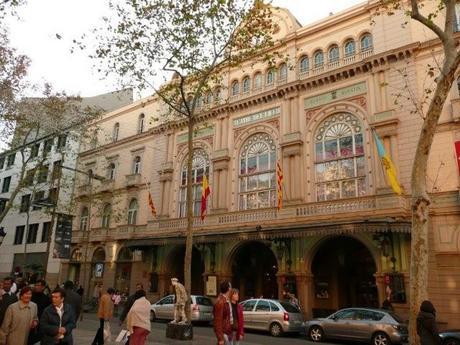Gran Teatre del Liceu
The Gran Teatre del Liceu was built in 1847 and is a unique cultural facility in Barcelona and one of Europe’s leading opera houses. Located on the Rambla, every year it hosts major opera and ballet productions and symphony concerts. The building was destroyed by fire in 1994 and reopened in 1999 after a magnificent reconstruction.
Barcelona's opera house, the Gran Teatre del Liceu, was founded on the Rambla in 1847 and has continued over the years to fulfil its role as a culture and arts centre and one of the symbols of the city.
Today it is publicly-owned (by the Government of Catalonia, Barcelona City Council, Barcelona Provincial Council and the Spanish Ministry of Culture) and administered by the Fundació del Gran Teatre del Liceu which, in addition to the aforementioned bodies, incorporates the Patronage Council and the Societat del Gran Teatre del Liceu (the old society of owners).
The Liceu evolved out of the Sociedad Dramática de Aficionados (Society of theatre-lovers) set up in 1837 at the instigation of Manuel Gibert in the former convent of Montsió by members of the National Militia, an organization of armed citizens with liberal leanings.
Barcelona's economy and population were growing fast at the time and the city needed a music conservatory. This led to the conversion of the Sociedad Dramática into the Liceo Filármonico Dramático Barcelonés de S.M. la Reina Isabel II (Barcelona Dramatic and Philharmonic Lyceum of HM Queen Isabel II). In addition to its theatrical activities, the new organization cultivated Italian-style singing and music.
The original building was solemnly opened on 4 April 1847. The plans had been drawn up by Miquel Garriga i Roca, subsequently assisted by Josep Oriol Mestres. The project was funded by selling shares, which meant that many of the boxes and seats were to be privately owned. The shareholders formed the Societat del Gran Teatre del Liceu, known as the “Societat de Propietaris” (Society of Owners), which was in sole charge of running the Gran Teatre del Liceu from 1855 onwards, after it was legally separated from the Conservatori del Gran Teatre del Liceu.
The theatre was operated by impresarios who were given a concession to stage a specific number of productions in exchange for the proceeds from the sale of tickets not reserved for the Societat itself. This system was to endure until 1980.
By the last quarter of the 20th century, this management system was no longer viable. In 1980, to avert the danger of the disappearance of an institution of such worldwide cultural renown, the Generalitat - Catalonia's first government in modern times – set up a consortium, the Consorci del Gran Teatre del Liceu, which also incorporated Barcelona City Council and the Societat del Gran Teatre del Liceu. Barcelona Provincial Council joined the Consortium in 1985, followed by the Spanish Ministry of Culture in 1986. From then on the Consortium took over operation of the theatre.
The fire that destroyed the Auditorium and stage on 31 January 1994 had a great impact on Catalan society and the Liceu's very existence was called into question. It was decided to rebuild and improve the emblematic building and to create a new legal framework to put it under public ownership. Thus the Fundació del Gran Teatre del Liceu was created in 1994 and the Societat del Gran Teatre del Liceu surrendered its property rights to the public authorities. This hand-over was ratified in 1997.
The theatre was rebuilt on the basis of a pre-existing Refurbishment and Enlargement Project, drawn up in 1986 by Ignasi de Solà-Morales with later input (1986) from Xavier Fabré and Lluís Dilmé. The new theatre looked very much like its predecessor but was endowed with state-of-the-art technical equipment and enlarged by taking over adjoining lots on the Rambla. It opened its doors on 7 October 1999.
The Gran Teatre del Liceu was built on the Rambla by Barcelona’s affluent classes on the site of a former convent. It was designed to house the Music Conservatory and with the main purpose of creating a venue where high society could go to see opera, the star cultural attraction of the time. The Liceu soon became a Barcelona landmark, to such an extent that its destruction by the fire in 1994 sent shockwaves through Catalan society. The reconstruction project provided the Liceu building with highly advanced technical facilities and stage equipment, and faithfully restored the original splendour of one of the most well-known opera houses.
The five-tier auditorium seats 2,292, making the Gran Teatre del Liceu on Barcelona’s Rambla one of the world’s biggest opera houses. The season of opera, dance and music runs from September to July. There are also guided tours of the main areas of the theatre, allowing visitors to enjoy every detail and the magnificence of its architecture. Highlights include the main auditorium, the foyer and hall of mirrors, as well as the Cercle del Liceu, a private club which is a superb example of Catalan art nouveau, or modernisme. It contains period furniture and original works by the painter Ramon Casas. You can get there via direct flight to Barcelona or to Girona, Reus or Lleida–Alguaire.




